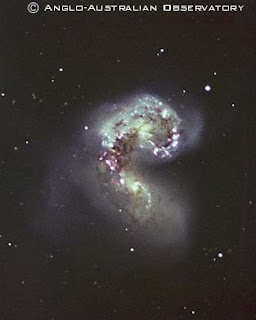Astronomy


- Picture Of The Day - Nov 5
Picture Of The Day 2012 November , 5 ...
- Picture Of The Day Oct - 25
Picture Of The Day October 25 , Thursday The Cone Nebula (NGC 2264) ...
- Elliptical Galaxy
Elliptical Galaxy ...
- Picture Of The Day
Picture Of The Day October 17, Wednesday ...
- Galaxy
Picture Of The Day(Stars and Galaxies) Galaxy ...
Astronomy
Irregular Galaxy
Irregular Galaxy
As the name suggests, "irregular" galaxies have no specific form, and so the group contains a very diverse selection of objects. In fact, there are two types of irregular galaxy. Type I's are usually single galaxies of peculiar appearance. They contain a large fraction of young stars, and show the luminous nebulae that are also visible in spiral galaxies. Type II irregulars include the group known as interacting or disrupting galaxies, in which the strange appearance is due to two or more galaxies colliding, merging or otherwise interacting gravitationally. Type II's appear to contain a large amount of dust.
Most irregulars are small and faint. The dwarf irregulars may be the most common type of galaxy in the universe (or maybe the dwarf ellipticals are). The estimates of the number of dwarf irregulars and dwarf ellipticals are based on the proportions of these types of galaxies in nearby groups. The dwarf galaxies far away are too faint to be seen and are, therefore, overlooked in surveys of the sky. Perhaps if the dwarf galaxies were brighter, Hubble would have arranged the galaxies in a different sequence instead of the two-pronged sequence. Examples of irregular galaxies are the Large and Small Magellanic Clouds (two small irregulars that orbit the Milky Way).
Type 1 Irregular Galaxy :

( ngc55)
In the light of the name "irregular", it is perhaps surprising that some systematic structure is observed in the type I galaxies. In fact, they are most closely related to spirals, and this is a relation which is alluded to in the presence of disks and bulges like their more orderly counterparts. However, it is here that the similarity ends, since the disks of irregular galaxies certainly show no sign of the spiral structure, and the galactic bulges are not even located at the centre of the object .These galaxies may in some ways be regarded as "primitive". They are relatively poor in "heavy" elements
Type II irregulars galaxy :

Type II irregular galaxies are remarkable, and often very spectacular, objects. They can be formed by several mechanisms, and one of the most common is a gravitational interaction with another nearby galaxy.
The idea of collisions between galaxies might at first seem unlikely. In general, galaxies are widely scattered, and there exists so much space between one and the next, that only one collision would occur in around 100 times the age of the universe, so that we would not expect to see any of these objects. However, it must be remembered that galaxies often exist in clusters, where the average spacing between cluster members is much smaller.- Picture Of The Day - Nov 5
Picture Of The Day 2012 November , 5 ...
- Picture Of The Day Oct - 25
Picture Of The Day October 25 , Thursday The Cone Nebula (NGC 2264) ...
- Elliptical Galaxy
Elliptical Galaxy ...
- Picture Of The Day
Picture Of The Day October 17, Wednesday ...
- Galaxy
Picture Of The Day(Stars and Galaxies) Galaxy ...
